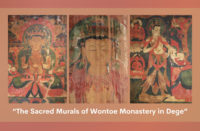
 High Peaks Pure Earth presents the English translation of a blogpost by well-known Tibetan writer Jamyang Kyi titled “Women and Their Ornamentation” that was published on her blog on January 2, 2014.
High Peaks Pure Earth presents the English translation of a blogpost by well-known Tibetan writer Jamyang Kyi titled “Women and Their Ornamentation” that was published on her blog on January 2, 2014.
Jamyang Kyi is an outspoken advocate for women’s rights inside Tibet and has not shied away from topics such as rape, prostitution and gender discrimination. This blogpost is concerned with Tibetan society and the symbolism and issues of ownership behind women’s braided hair in Amdo. A custom in central Tibet for married women to wear an apron on their dress is also mentioned in the post.
There is little in the way of discussion or studies of women’s hairstyles available, however there is one English-language 2012 paper on the symbolic significance of hair available through PlateauCulture.Org.
High Peaks Pure Earth is very grateful to Tenzin Nyinjey for submitting this English translation.
“Women and Their Ornamentation”
By Jamyang Kyi
In rural areas of Amdo, when girls attain the age of sixteen or seventeen, they have to go through a hair-braiding ritual ceremony. After going through such a ceremony, a girl is considered to have achieved womanhood. And to symbolise, this she puts on hair plaits, representing a husband’s soul and economic wellbeing.
[In other words], after going through the hair-braiding ritual ceremony, a woman is now considered to be ready to sent away as a bride. Once they are married, like dark shadows of their bodies, women are not allowed to part with their hair plaits.
If women refused to wear hair plaits, people would suspect that they have been widowed. Because of such a belief, women suffer from an intense fear when they part with the hair plaits.
My mother became physically weak after having been sick for a long time. As a result, she had trouble wearing her hair plaits. So I suggested her to do away with them. Although she strongly agreed with my suggestion, she suffered from an intense fear [that prevented her from carrying out her decision]. Later her sickness worsened – to such a degree that it was impossible for her to bear the heavy burden of carrying hair plaits on her shoulders.
After an arduous struggle, my mother made a habit of not wearing her hair plaits – she felt quite uncomfortable with this given her husband was still alive. As a result, my father had to grant her the permission to do away with her hair plaits. This made me realise how difficult it is for women in a rural area to resist age-old traditions without a little encouragement from others and confidence in oneself.
Ten years ago, I visited Lhasa. This was the time when Tibetans were celebrating the opera festival. So I too went to Norbulingka – the site of the festival – where I met with some of my friends who work for Tibet TV. At the time I was wearing a sleeveless Lhasa chupa, without the apron. Seeing this, some of my women friends asked me, ‘Are you not married?’
To which I responded, ‘I am not only married, but also have children.’
Surprised at what I said, they asked me, ‘But how come you are not wearing an apron?’
I told them, ‘As far as Amdo is concerned, this custom of wearing Lhasa’s sleeveless chupa and apron is relatively new. In fact, most of us are hardly aware of this custom. I didn’t feel like wearing an apron, that’s why I didn’t wear it.’
Hearing this, they told me, with a sense of joy, ‘Wow, how great for you!’
I told them that if they didn’t feel like wearing an apron, then they shouldn’t wear it.
To which they replied, ‘If we don’t wear an apron after getting married, people might suspect that we are widows.’ The conversation made me understand that [in Central Tibet] the apron is considered as a symbol representing the soul of man – a custom not unlike that of wearing hair plaits by women in rural Amdo.
The deep sense of joy they expressed at my not wearing an apron seems to suggest that Tibetan women wear aprons not out of love, but to symbolize that they are married and have not been widowed. They regard wearing an apron as an act of obligation rather than ornamentation.
Mangsa Pekar, the sculptress, wrote an essay about how woman’s ornamentation represented symbols of [ownership]:
“As far as men are concerned, they agree more to spend their time making women more beautiful by ornamenting them with gold and silver rather than believing that women have their own thoughts. Throughout history, women in Tibet have become like storehouses for preserving men’s souls and economic wealth. After marriage, women in Central Tibet have to wear aprons, those in Kham amber hairpieces, and in Amdo hair-plaits. All of these ornamentations symbolise the ownership of women. Women have been made to think that ornamentations or jewelries enhance their beauty – in the process losing their consciousness or souls. Such paraphernalia have become like iron-chains shackling women after marriage.”
I think this is a true observation.
Many years ago, I visited a town with two married Muslim women for the sake of doing some work. The two women were working at a county office dedicated to art and culture. After spending two months with them and becoming close to them, I found that they were very critical about the lack of status for women in their society and resented the Muslim custom of wearing burqa after marriage. One of the women told me, ‘without the knowledge of my husband and family members, I threw my burqa away and roamed the Chinese streets on my own. But in front of my husband and when visiting my family, I had to wear burqa.’
According to what she said, this custom is a source of unease to her, but it appears she’s lacking courage to resist it. Before I met them, I was of the view that Muslim women respected the marriage customs and didn’t resist the boundaries set upon them by tradition. Now I have realised fully that this was not the case – that such customs are a source of heartache for them. And why not! After all, women do have other sources of beauty apart from hair-plaits. As a woman myself, I detest any dress or jewelry meant to ‘enhance woman’s beauty.’
Seeing the two Muslim women enjoying two months’ feast of heartfelt joy and peace – away from their homeland – I felt that even the strict boundaries of tradition have not succeeded in fully subjecting the mind, body and soul of women. I was wondering whether the fact that they appeared like two creatures escaped from snares is due to the many restrictions that tradition impose on women in their daily lives.
Generally, it is the issue of an individual – a personal matter. So maybe we don’t have to delve into it. But one thing that I want to express is this: any [one] who attempts to destroy innate human personality or trait by sheer force shows that he or she is not well aware of the true human nature.
Some of the examples given above clearly show that women covertly resent and resist customs that forces them – that is against their wishes – to wear certain clothes for their husbands’ sake. Man is an individual being who regards his own individual self the most important thing. Women are no exception.
Translated from the Tibetan by Tenzin Nyinjey




There is a new article: “The Path of a Woman” by Jamyang Kyi http://sangdhor.com/blog_c.asp?id=13376&a=menzhu
Very true. However, I am afraid that there are lot of people out there who can’t differentiate between superstition and real. I am no exception. The line is very thin to realize where one ends, and the other begins.
This is really an insight into women’s struggle to create their own identity. Never given a thought about Tibetan apron would symbolise ownership, where man doesn’t need to go through the hassle. It is indeed a problem that always women has to put on thousands of thoughts to small things, sacrifice their liberty for some1 else’s liberty. Women are never considered as whole individuals but rather a shared soul, inferior to man and in society.
This is really an insight into women’s struggle to create their own identity. Never given a thought about Tibetan apron would symbolise ownership, where man doesn’t need to go through the hassle. It is indeed a problem that always women has to put on thousands of thoughts to small things, sacrifice their liberty for some1 else’s liberty. Women are never considered as whole individuals but rather a shared soul, inferior to man and not worthy of individualism.